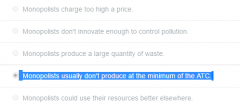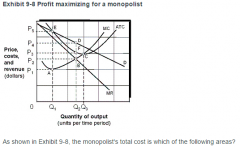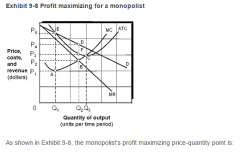![]()
![]()
![]()
Use LEFT and RIGHT arrow keys to navigate between flashcards;
Use UP and DOWN arrow keys to flip the card;
H to show hint;
A reads text to speech;
19 Cards in this Set
- Front
- Back
|
Which of the following is not associated with the monopoly market structure? - Many sellers -A single seller -A unique product -Impossible entry into the market. |
Many Sellers |
|
|
For a monopoly to successfully price discriminate, its customers must: - feel that the product is a necessity. -have identical demands. -be unable to resell the product. - actively engage in arbitrage. |
be unable to resell the product. |
|
|
A perfectly competitive firm is a price taker, but a monopoly is a price maker. t/f |
True |
|
|
The goal of any monopolist is to maximize: |
Economic Profit |
|
|
Monopolists are criticized because they are inefficient. What is meant by this statement? |

Monopolists usually don't produce at the minimum of the ATC. |
|

|

|
|
|
A monopoly market is characterized by a single seller of a product which has few, if any, suitable substitutes. T/F |
True |
|
|
Compared to a perfectly competitive industry, a monopolist with the same marginal cost and demand curve will charge: - a higher price and produce a higher volume of output. - a lower price and produce a higher volume of output. - a lower price and produce a lower volume of output. -a higher price and produce a lower volume of output. -the same price and produce the same volume of output. |

|
|
|
The monopolist faces the market demand curve. t/f |
True |
|
|
At a price of $5, 24 units of the good would be sold; at a price of $7, 25 units of output would be sold. The marginal revenue of the 25th unit of output is: |
$55 |
|
|
A monopolist always selects a price on the elastic portion of its demand curve. t/f |
True |
|
|
what represents an arbitrage transaction? |
A trader buys a block of government bonds in one market where it is temporarily priced below where it can be immediately resold in a different market. |
|
|
The strategy underlying price discrimination is to: |
increase total revenue by charging higher prices to those with the most inelastic demand for the product and lower prices to those with the most elastic demand. |
|
|
____ is the act of buying a coimodity in one market at a lower price and selling it in another market at a higher price. |
Arbitrage |
|
|
A monopoly will price its product: |
at that point on the market demand curve corresponding to an output level in which marginal revenue equals marginal cost. |
|

|

|
|
|
Which of the following is a difference between a monopolist and a firm in perfect competition? -The marginal revenue curve is downward-sloping. -Marginal revenue equals price. -Economic profits are zero in the long-run. -The marginal revenue curve lies above the demand curve. |
The marginal revenue curve is downward-sloping. |
|
|
An example of price discrimination is the price charged for: |
theater tickets that offer lower prices for children. |
|
|
Although a monopoly can charge any price it wishes, it chooses: |
the price that maximizes profit. |

